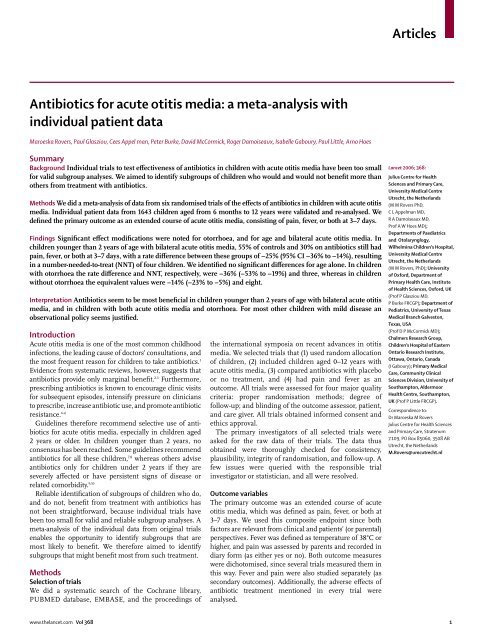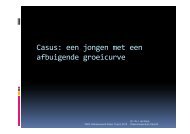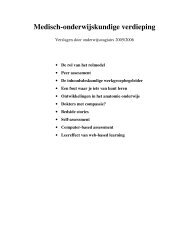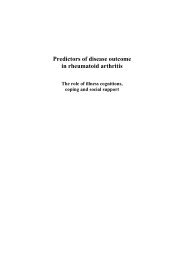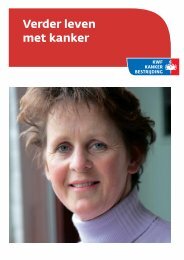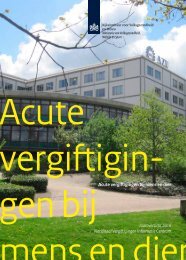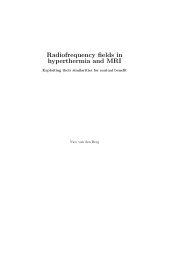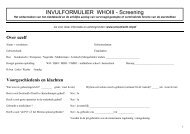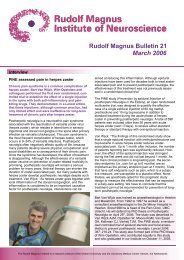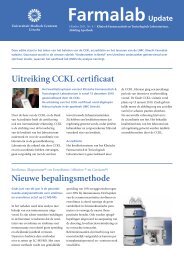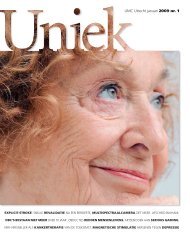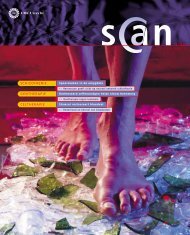Articles Antibiotics for acute otitis media: a meta ... - UMC Utrecht
Articles Antibiotics for acute otitis media: a meta ... - UMC Utrecht
Articles Antibiotics for acute otitis media: a meta ... - UMC Utrecht
You also want an ePaper? Increase the reach of your titles
YUMPU automatically turns print PDFs into web optimized ePapers that Google loves.
<strong>Articles</strong><br />
<strong>Antibiotics</strong> <strong>for</strong> <strong>acute</strong> <strong>otitis</strong> <strong>media</strong>: a <strong>meta</strong>-analysis with<br />
individual patient data<br />
Maroeska Rovers, Paul Glasziou, Cees Appel man, Peter Burke, David McCormick, Roger Damoiseaux, Isabelle Gaboury, Paul Little, Arno Hoes<br />
Summary<br />
Background Individual trials to test effectiveness of antibiotics in children with <strong>acute</strong> <strong>otitis</strong> <strong>media</strong> have been too small<br />
<strong>for</strong> valid subgroup analyses. We aimed to identify subgroups of children who would and would not benefit more than<br />
others from treatment with antibiotics.<br />
Methods We did a <strong>meta</strong>-analysis of data from six randomised trials of the effects of antibiotics in children with <strong>acute</strong> <strong>otitis</strong><br />
<strong>media</strong>. Individual patient data from 1643 children aged from 6 months to 12 years were validated and re-analysed. We<br />
defined the primary outcome as an extended course of <strong>acute</strong> <strong>otitis</strong> <strong>media</strong>, consisting of pain, fever, or both at 3–7 days.<br />
Findings Significant effect modifications were noted <strong>for</strong> otorrhoea, and <strong>for</strong> age and bilateral <strong>acute</strong> <strong>otitis</strong> <strong>media</strong>. In<br />
children younger than 2 years of age with bilateral <strong>acute</strong> <strong>otitis</strong> <strong>media</strong>, 55% of controls and 30% on antibiotics still had<br />
pain, fever, or both at 3–7 days, with a rate difference between these groups of −25% (95% CI −36% to −14%), resulting<br />
in a number-needed-to-treat (NNT) of four children. We identified no significant differences <strong>for</strong> age alone. In children<br />
with otorrhoea the rate difference and NNT, respectively, were −36% (−53% to −19%) and three, whereas in children<br />
without otorrhoea the equivalent values were −14% (−23% to −5%) and eight.<br />
Interpretation <strong>Antibiotics</strong> seem to be most beneficial in children younger than 2 years of age with bilateral <strong>acute</strong> <strong>otitis</strong><br />
<strong>media</strong>, and in children with both <strong>acute</strong> <strong>otitis</strong> <strong>media</strong> and otorrhoea. For most other children with mild disease an<br />
observational policy seems justified.<br />
Introduction<br />
Acute <strong>otitis</strong> <strong>media</strong> is one of the most common childhood<br />
infections, the leading cause of doctors’ consultations, and<br />
the most frequent reason <strong>for</strong> children to take antibiotics. 1<br />
Evidence from systematic reviews, however, suggests that<br />
antibiotics provide only marginal benefit. 2,3 Furthermore,<br />
prescribing antibiotics is known to encourage clinic visits<br />
<strong>for</strong> subsequent episodes, intensify pressure on clinicians<br />
to prescribe, increase antibiotic use, and promote antibiotic<br />
resistance. 4–6<br />
Guidelines there<strong>for</strong>e recommend selective use of antibiotics<br />
<strong>for</strong> <strong>acute</strong> <strong>otitis</strong> <strong>media</strong>, especially in children aged<br />
2 years or older. In children younger than 2 years, no<br />
consensus has been reached. Some guidelines recommend<br />
antibiotics <strong>for</strong> all these children, 7,8 whereas others advise<br />
antibiotics only <strong>for</strong> children under 2 years if they are<br />
severely affected or have persistent signs of disease or<br />
related comorbidity. 9,10<br />
Reliable identification of subgroups of children who do,<br />
and do not, benefit from treatment with antibiotics has<br />
not been straight<strong>for</strong>ward, because individual trials have<br />
been too small <strong>for</strong> valid and reliable subgroup analyses. A<br />
<strong>meta</strong>-analysis of the individual data from original trials<br />
enables the opportunity to identify subgroups that are<br />
most likely to benefit. We there<strong>for</strong>e aimed to identify<br />
subgroups that might benefit most from such treatment.<br />
Methods<br />
Selection of trials<br />
We did a systematic search of the Cochrane library,<br />
PUBMED database, EMBASE, and the proceedings of<br />
the international symposia on recent advances in <strong>otitis</strong><br />
<strong>media</strong>. We selected trials that (1) used random allocation<br />
of children, (2) included children aged 0–12 years with<br />
<strong>acute</strong> <strong>otitis</strong> <strong>media</strong>, (3) compared antibiotics with placebo<br />
or no treatment, and (4) had pain and fever as an<br />
outcome. All trials were assessed <strong>for</strong> four major quality<br />
criteria: proper randomisation methods; degree of<br />
follow-up; and blinding of the outcome assessor, patient,<br />
and care giver. All trials obtained in<strong>for</strong>med consent and<br />
ethics approval.<br />
The primary investigators of all selected trials were<br />
asked <strong>for</strong> the raw data of their trials. The data thus<br />
obtained were thoroughly checked <strong>for</strong> consistency,<br />
plausibility, integrity of randomisation, and follow-up. A<br />
few issues were queried with the responsible trial<br />
investigator or statistician, and all were resolved.<br />
Outcome variables<br />
The primary outcome was an extended course of <strong>acute</strong><br />
<strong>otitis</strong> <strong>media</strong>, which was defined as pain, fever, or both at<br />
3–7 days. We used this composite endpoint since both<br />
factors are relevant from clinical and patients’ (or parental)<br />
perspectives. Fever was defined as temperature of 38°C or<br />
higher, and pain was assessed by parents and recorded in<br />
diary <strong>for</strong>m (as either yes or no). Both outcome measures<br />
were dichotomised, since several trials measured them in<br />
this way. Fever and pain were also studied separately (as<br />
secondary outcomes). Additionally, the adverse effects of<br />
antibiotic treatment mentioned in every trial were<br />
analysed.<br />
Lancet 2006; 368:<br />
Julius Centre <strong>for</strong> Health<br />
Sciences and Primary Care,<br />
University Medical Centre<br />
<strong>Utrecht</strong>, the Netherlands<br />
(M M Rovers PhD,<br />
C L Appelman MD,<br />
R A Damoiseaux MD,<br />
Prof A W Hoes MD);<br />
Departments of Paediatrics<br />
and Otolarynglogy,<br />
Wilhelmina Children’s Hospital,<br />
University Medical Centre<br />
<strong>Utrecht</strong>, the Netherlands<br />
(M M Rovers, PhD); University<br />
of Ox<strong>for</strong>d, Department of<br />
Primary Health Care, Institute<br />
of Health Sciences, Ox<strong>for</strong>d, UK<br />
(Prof P Glasziou MD,<br />
P Burke FRCGP); Department of<br />
Pediatrics, University of Texas<br />
Medical Branch Galveston,<br />
Texas, USA<br />
(Prof D P McCormick MD);<br />
Chalmers Research Group,<br />
Children’s Hospital of Eastern<br />
Ontario Research Institute,<br />
Ottawa, Ontario, Canada<br />
(I Gaboury); Primary Medical<br />
Care, Community Clinical<br />
Sciences Division, University of<br />
Southampton, Aldermoor<br />
Health Centre, Southampton,<br />
UK (Prof P Little FRCGP).<br />
Correspondence to:<br />
Dr Maroeska M Rovers<br />
Julius Centre <strong>for</strong> Health Sciences<br />
and Primary Care, Stratenum<br />
7.109, PO Box 85060, 3508 AB<br />
<strong>Utrecht</strong>, the Netherlands<br />
M.Rovers@umcutrecht.nl<br />
www.thelancet.com Vol 368 1
<strong>Articles</strong><br />
Independent predictors of an extended course of<br />
disease had been established in an earlier study within<br />
the same setting (unpublished data). 11 We used these<br />
independent baseline predictors—ie, age (0.30) indicating that studies<br />
were sufficiently similar to justify pooling of data.<br />
We calculated relative risks (RR), rate differences (RD),<br />
and NNT, with their 95% CI, <strong>for</strong> both the primary and<br />
secondary outcomes. To assess whether the effect of<br />
antibiotics was modified by age, bilateral <strong>acute</strong> <strong>otitis</strong> <strong>media</strong>,<br />
fever, otorrhoea, or a combination of these factors, we did a<br />
fixed-effect logistic regression analysis. In this model, the<br />
independent variables were: treatment with antibiotics (yes<br />
vs no); the potential-effect modifiers (age, bilateral <strong>acute</strong><br />
<strong>otitis</strong> <strong>media</strong>, fever, otorrhoea, or combinations of these);<br />
and an interaction term (defined as use of antibiotics times<br />
potential-effect modifier). We also used a binary dummy<br />
variable to identify each study within the regression<br />
analysis. Dependent variables were an extended course<br />
(primary outcome), fever, and pain at 3–7 days (secondary<br />
outcomes). We calculated the c-index (area under the<br />
receiver operating curve) to measure the accuracy of each<br />
model. If a significant interaction effect was identified, we<br />
did stratified analyses of the rate ratios and rate differences<br />
within each stratum of the subgroups. The percentages of<br />
children with an extended course during each consecutive<br />
day within each of the identified subgroups were calculated<br />
<strong>for</strong> the five trials that asked parents to fill out diaries noting<br />
signs of the disease. Finally, we did sensitivity analyses,<br />
including only those trials that measured the outcomes on<br />
the same day, used the same dose regimen, or included<br />
placebo. All analyses were per<strong>for</strong>med according to the<br />
intention to trat principle.<br />
Role of the funding source<br />
This study was sponsored by the Dutch College of General<br />
Practitioners and the Netherlands Organisation <strong>for</strong> Health<br />
Research and Development (grant number 4200.0010).<br />
Number of<br />
patients<br />
Participants Interventions Duration of<br />
intervention<br />
Ref 22 121 Children aged 6 months to 12 years<br />
visiting a GP with recurrent AOM<br />
Amoxicillin with clavulanate vs<br />
placebo<br />
Outcomes<br />
7 days Fever after 3 days<br />
Pain after 3 days<br />
Otorrhoea<br />
Otoscopy and tympanometry after 1 month<br />
Ref 23 232 Children aged 3 to 10 years with AOM Amoxicillin vs placebo 7 days Symptoms noted by parents (including fever and ear pain)<br />
Home visits by researcher after 24 h and 5–7 days<br />
Otoscopy and tympanometry after 1 and 3 months<br />
Ref 24 240 Children aged 6 months to 2 years<br />
visiting a GP with AOM<br />
Ref 25 315 Children aged 6 months to 10 years<br />
visiting a GP with AOM<br />
Ref 26 512 Children aged 6 months to 5 years<br />
presenting to clinics or the emergency<br />
department with AOM<br />
Ref 27 223 Children aged 6 months to 12 years<br />
with AOM<br />
AOM = <strong>acute</strong> <strong>otitis</strong> <strong>media</strong>; GP = general practitioner<br />
Table 1: Characteristics of the six trials included in our <strong>meta</strong>-analysis<br />
Amoxicillin vs placebo 10 days Symptoms at day 4 assessed by a GP (including fever and earpain)<br />
Otoscopy and tympanometry after 6 weeks and 3 months<br />
Im<strong>media</strong>te antibiotics (amoxicillin) vs<br />
delayed treatment<br />
7 days Symptoms noted by parents (including fever and earpain)<br />
Absence from school<br />
Consumption of paracetamol<br />
Amoxicillin vs placebo 10 days Telephone follow-up at day 1, 2, 3, and between 10 and 14 days<br />
(including fever)<br />
Tympanometry at 1 and 3 months<br />
Im<strong>media</strong>te antibiotics (amoxicillin) vs<br />
delayed treatment<br />
10 days Symptoms noted by parents (including fever and earpain)<br />
Analgesic consumption<br />
Nasopharyngeal carriage<br />
Adverse events<br />
Absence from school<br />
Tympanometry after 12 and 30 days<br />
2 www.thelancet.com Vol 368
<strong>Articles</strong><br />
This sponsor had no role in study design, data collection,<br />
data analysis, data interpretation, or writing of the report.<br />
The corresponding author had full access to all the data in<br />
the study and had final responsibility <strong>for</strong> the decision to<br />
submit <strong>for</strong> publication.<br />
Results<br />
Our search strategy identified nineteen trials that<br />
investigated the effectiveness of antibiotics in children<br />
with <strong>acute</strong> <strong>otitis</strong> <strong>media</strong>. After screening, nine trials were<br />
excluded, because randomisation was inadequate, the<br />
control group received another treatment, in<strong>for</strong>mation<br />
about our selected outcomes was not available, or because<br />
they focused on special study populations, such as children<br />
with ventilation tubes. 13–21 Of the ten eligible trials, six<br />
research groups provided us with their data 23–28 and four<br />
did not. 29–32 The methodological quality of the six remaining<br />
studies was generally high. Five used adequate concealed<br />
allocations (blinded randomisations) and outcome<br />
assessments. Loss to follow-up was less than 10%. Table 1<br />
shows the main characteristics of the six trials. The mean<br />
age of the children was 3·4 years (range 0–11 ); half were<br />
boys; about half had recurrent <strong>acute</strong> <strong>otitis</strong> <strong>media</strong>; and<br />
about a third had bilateral <strong>acute</strong> <strong>otitis</strong> <strong>media</strong> (table 2).<br />
Our <strong>meta</strong>-analysis showed that, relative to placebo,<br />
overall RR <strong>for</strong> an extended course of <strong>acute</strong> <strong>otitis</strong> <strong>media</strong> at<br />
3–7 days with antibiotics was 0·83 (95% CI 0·78–0·89).<br />
The rate difference between the control group and the<br />
antibiotics group was 13% (9–17), resulting in a NNT of<br />
eight children. Overall RR of fever at 3–7 days was 0·95<br />
(0·92–0·98); the rate difference was 5% (2–8) and NNT<br />
was 20 children. The corresponding proportions of<br />
children who had pain at 3–7 days were 0·86 (0·81–0·91);<br />
11% (7–15); and ten children, respectively.<br />
Our analyses showed that the effect of antibiotics was<br />
modified by age and bilateral disease, and by otorrhoea,<br />
notably <strong>for</strong> the primary outcome of pain, fever, or both at<br />
3–7 days (table 3). In children aged less than 2 years with<br />
bilateral <strong>acute</strong> <strong>otitis</strong> <strong>media</strong>, more than half the control<br />
group and less than a third of the antibiotics group still<br />
had pain, fever, or both at 3–7 days, with a rate difference of<br />
about 25%. In children aged 2 years or older with bilateral<br />
disease the rate difference was about 12%. For age alone no<br />
differences were identified. The c-indices, calculated to<br />
gauge the accuracy of each model, were 0·63, 0·58 and<br />
0·61, respectively, <strong>for</strong> age and bilaterality, age alone, and<br />
bilaterality alone.<br />
About 60% of children with otorrhoea in the control<br />
group had pain, fever, or both at 3–7 days, whereas only<br />
about 25% of those given antibiotics had protracted<br />
illnesses. The rate difference, of about 36%; was much<br />
greater than that <strong>for</strong> those without otorrhoea, which was<br />
about 14%. Other factors, in combination with otorrhoea,<br />
such as age, bilateral disease, or both did not substantially<br />
alter this pattern—ie, children with otorrhoea seemed to<br />
benefit most from treatment with antibiotics, irrespective<br />
of other characteristics.<br />
<strong>Antibiotics</strong><br />
(n=819)<br />
Controls<br />
(n=824)<br />
Total<br />
(n=1643)<br />
Age
<strong>Articles</strong><br />
Number(%)<br />
Group given<br />
antibiotics<br />
Control<br />
group<br />
RD (95% CI) NNT RR (95% CI) p-value <strong>for</strong><br />
interaction*<br />
Pain, fever, or both at 3–7 days (n=819) (n=824) [A3]<br />
Age<br />
<strong>Articles</strong><br />
theless, some of our findings deserve further discussion.<br />
First, only six of the ten eligible randomised, controlled<br />
trials could be included in our <strong>meta</strong>-analysis. The main<br />
characteristics of the four trials <strong>for</strong> which individual patient<br />
data were not available were, however, much the same as<br />
those in the six included trials. Moreover, the overall results<br />
of our subset of six trials are very similar to the overall<br />
results reported by the Cochrane review 3 that did include<br />
all trials. A funnel plot of the included studies (data not<br />
shown) also indicated that publication bias was unlikely.<br />
Second, we could not do a pooled analysis with respect to<br />
failure rates since these rates were defined and measured<br />
differently in each of the six included trials. We did,<br />
however, undertake subgroup analyses of failure rate<br />
within each trial, and subsequently pooled these results <strong>for</strong><br />
the six trials. The results were in accord with the pooled<br />
results <strong>for</strong> the subgroups—ie, the largest effect of<br />
antibiotics was in children aged younger than 2 years with<br />
bilateral <strong>acute</strong> <strong>otitis</strong> <strong>media</strong> (rate difference −8%, 95% CI<br />
−17% to 0%), and the smallest effect was in children aged 2<br />
years or older with unilateral <strong>acute</strong> <strong>otitis</strong> <strong>media</strong> (rate<br />
difference −3%, −7% to 1%).<br />
Third, the severity of the pain was estimated by parents<br />
and not further quantified in the trials, which could have<br />
resulted in an incorrect estimation of the real pain. Analysis<br />
with fever alone, however, showed much the same trend.<br />
Moreover, the fact that in many children the complaints at<br />
days 3–7 were mild should be taken into account in<br />
interpretation of reported NNTs and in the decision to<br />
initiate antibiotic therapy in individual patients.<br />
Fourth, the results are based on child participants, who<br />
might not be representative of those visiting general<br />
practitioners. For example, the most severely affected<br />
children might be under-represented. However, because<br />
we had access to raw data from six trials, we had high<br />
numbers of children from specific high-risk groups, which<br />
are often under-represented in single trials. Furthermore,<br />
the children we included seem representative of those with<br />
<strong>acute</strong> <strong>otitis</strong> <strong>media</strong> visiting general practitioners, since the<br />
percentages of those aged less than 2 years and 2 years or<br />
older were much the same as those from a national survey<br />
in Netherlands of children with <strong>acute</strong> <strong>otitis</strong> <strong>media</strong> in<br />
primary care (ie, 35% vs 33%, and 65% vs 67%,<br />
respectively). 34<br />
Fifth, the rate of mastoiditis was so low that we could not<br />
obtain a precise estimate <strong>for</strong> risk of this complication. The<br />
trials done so far, however, showed that initially withholding<br />
antibiotics from children with <strong>acute</strong> <strong>otitis</strong> <strong>media</strong> does not<br />
increase suppurative complications. Whether restrictive<br />
antibiotic use increases <strong>acute</strong> mastoiditis at the population<br />
level remains unresolved, but the potential increase is only<br />
two cases per 100 000 person-years and should be weighed<br />
against potential adverse effects. 1<br />
Sixth, since not all trials used the most objective<br />
diagnostic methods (eg, pneumatic otoscopy or<br />
tympanometry) some children in our <strong>meta</strong>-analysis might<br />
not have had ear infections. Sensitivity analyses with the<br />
three trials that did use these diagnostic methods were,<br />
however, in accord with the overall results.<br />
Seventh, we did not study all possible subgroups. We<br />
selected established predictors of an extended course of<br />
disease (unpublished data) 11 and some clinically relevant<br />
variables, and did stratified analyses only <strong>for</strong> those variables<br />
that showed a significant p-value <strong>for</strong> the interaction in the<br />
fixed regression model. We might there<strong>for</strong>e have missed<br />
a subgroup. Our approach is, however, in agreement<br />
Proportion of children (%)<br />
100<br />
90<br />
80<br />
70<br />
60<br />
50<br />
40<br />
30<br />
20<br />
10<br />
0<br />
A<br />
B<br />
100<br />
90<br />
80<br />
70<br />
60<br />
50<br />
40<br />
30<br />
20<br />
10<br />
0<br />
0 1 2 3 4 5<br />
Control group<br />
Antibiotic group<br />
C<br />
D<br />
6 7 8 9 10 0 1 2 3 4 5 6 7 8 9 10<br />
Days of follow-up<br />
Figure 1: Proportion of children with an extended cource of <strong>acute</strong> <strong>otitis</strong> <strong>media</strong><br />
A=≤2 yrs with bilateral disease; B=≥2 yrs with unilateral disease; C=with otorrhoea; and D=without otorrhoea.<br />
www.thelancet.com Vol 368 5
<strong>Articles</strong><br />
with recommendations <strong>for</strong> study of subgroups. 34 The<br />
strength of this approach is that our prognostic analyses<br />
revealed only a few relevant subgroups, limiting the<br />
number of subgroup analyses and subsequent falsepositive<br />
findings (type I error) that could be caused by<br />
multiple testing. Furthermore, other subgroups that<br />
might benefit more from treatment with antibiotics (eg,<br />
children with Down syndrome or cleft palate) could not<br />
be studied in this <strong>meta</strong>-analysis of individual patient<br />
data, because these subgroups were excluded in the<br />
individual trials. The experience of many clinicians that<br />
these subgroups of children benefit more from treatment<br />
with antibiotics has not yet been evidenced in randomised<br />
controlled trials.<br />
Eighth, we did not adjust <strong>for</strong> potential confounding<br />
due to differences between trials. We did, however,<br />
examine whether such confounding had occurred in our<br />
study, and noted that children aged less than 2 years<br />
were most likely to have fever and an abnormal tympanic<br />
membrane at baseline. We there<strong>for</strong>e used the Mantel<br />
Haenzel technique to adjust <strong>for</strong> these potential<br />
confounders in our subgroup analyses. Since the effect<br />
estimates were not altered by adjustments, crude effect<br />
estimates are presented.<br />
We conclude that antibiotics are beneficial in relieving<br />
residual pain or fever at 3–7 days in children younger<br />
than 2 years of age with bilateral <strong>acute</strong> <strong>otitis</strong> <strong>media</strong>, and<br />
in children with <strong>acute</strong> <strong>otitis</strong> <strong>media</strong> and otorrhoea. For<br />
most other children with mild disease an observational<br />
policy seems justified.<br />
Contributors<br />
MM Rovers designed and planned the study, and<br />
gathered, analysed, and interpreted the data. P Glasziou<br />
and AW Hoes contributed to the initial idea and design<br />
of the study, interpreted the data, and supervised the<br />
study. CL Appelman, P Burke, D McCormick, RA<br />
Damoiseaux, I Gaboury, and P Little provided the data of<br />
the original trials, contributed to the protocol, and<br />
interpreted the data. The manuscript was prepared by<br />
MMR, and all authors have seen and approved the final<br />
version.<br />
Conflict of interest statement<br />
We declare that we have no conflict of interest.<br />
Acknowledgments<br />
We thank Anne Schilder <strong>for</strong> commenting on an earlier version of this<br />
paper.<br />
References<br />
1 Rovers MM, Schilder AG, Zielhuis GA, Rosenfeld RM. Otitis<br />
<strong>media</strong>. Lancet 2004; 363: 465–73.<br />
2 Marcy M, Takata G, Shekelle P, et al. Management of Acute Otitis<br />
Media. Evidence Report/Technology Assessment No. 15 Rockville,<br />
MD: Agency <strong>for</strong> Healthcare Research and Quality, 2001.<br />
3 Glasziou PP, Del Mar CB, Sanders SL, Hayem M. <strong>Antibiotics</strong> <strong>for</strong><br />
<strong>acute</strong> <strong>otitis</strong> <strong>media</strong> in children. Cochrane Database Syst Rev. 2004;(1):<br />
CD000219.<br />
4 Britten N, Ukoumunne O. The influence of patients’ hopes of<br />
receiving a prescription on doctors’ perceptions and the decision to<br />
prescribe: a questionnaire survey. BMJ 1997; 315: 1506–10.<br />
5 MacFarlane J, Holmes W, MacFarlane R, Britten N. Influence of<br />
patients’ expectations on antibiotics management of <strong>acute</strong> lower<br />
respiratory illness in general practice: questionnaire study. BMJ<br />
1997; 315: 1211–1214.<br />
6 Arason V, Kristinsson K, Sigurdsson J, Stefansdottir G, Molstad S,<br />
Gudmundsson S. Do antimicrobials increase the rate of penicillin<br />
resistant pneumococci in children? Cross sectional prevalence<br />
study. BMJ 1996; 313: 387–91.<br />
7 American Academy of Pediatrics. Clinical practice guideline:<br />
Diagnosis and Management of Acute Otitis Media. Pediatrics 2004;<br />
113: 1451–65.<br />
8 United Kingdom Department of Health. PRODIGY guidance:<br />
Otitis <strong>media</strong>–<strong>acute</strong>. 2004. http://www.prodigy.nhs.uk. (accessed on<br />
Sept 14, 2006)<br />
9 Appelman CLM, van Balen FAM, van de Lisdonk EH, van Weert<br />
HCPM, Eizenga WH. NHG–Standaard Otitis Media Acuta. Huisarts<br />
en Wetenschap 1999; 42: 362–66.<br />
10 Scottish Intercollegiate Guidelines Network. Diagnosis and<br />
management of childhood <strong>otitis</strong> <strong>media</strong> in primary care. 2003.<br />
http://www.sign.ac.uk. (accessed on Sept 14, 2006).<br />
11 Greenland S, Finkle WD. A critical look at methods <strong>for</strong> handling<br />
missing covariates in epidemiologic regression analyses. Am J<br />
Epidemiol 1995; 142: 1255–64.<br />
12 Higgins JP, Thompson SG, Deeks JJ, Altman DG. Measuring<br />
inconsistency in <strong>meta</strong>-analyses. BMJ 2003; 327: 557–60.<br />
13 de Chaput Saintonge DM, Levine DF, Temple Savage IT, et al. Trial<br />
of three-day and ten-day courses of amoxycillin in <strong>otitis</strong> <strong>media</strong>. Br<br />
Med J (Clin Res Ed) 1982; 284: 1078–81.<br />
14 Engelhard D, Strauss N, Jorczak-Sarni L, Cohen D, Sacjs TG,<br />
Shapiro, M. Randomised study of myringotomy, amoxycillin/<br />
clavulanate, or both <strong>for</strong> <strong>acute</strong> <strong>otitis</strong> <strong>media</strong> in infants. Lancet 1989; 2:<br />
141–43.<br />
15 Ostfeld E, Segal J, Kaufstein M, Gelernter I. Management of <strong>acute</strong><br />
<strong>otitis</strong> <strong>media</strong> without primary administration of systemic<br />
antimicrobial agents. In: Lim DJ, Bluestone CD, Klein JO, Nelson<br />
JD, eds. Recent advances in <strong>otitis</strong> <strong>media</strong>. Proceedings of the Fourth<br />
International Symposium. Toronto: BC Decker, 1987: 235–39.<br />
16 Rudberg, RD. Acute <strong>otitis</strong> <strong>media</strong>: comparative therapeutic results of<br />
sulphonamide and penicillin administered in various <strong>for</strong>ms.<br />
Acta Otolaryngology 1954; 113: 1–79.<br />
17 Ruohola A, Heikkinen T, Meurman O, Puhakka T, Lindblad N,<br />
Ruuskanen O. Antibiotic treatment of <strong>acute</strong> otorrhea through<br />
tympanostomy tube: Randomized double-blind placebo-controlled<br />
study with daily follow-up. Pediatrics 2003; 111: 1061–67.<br />
18 van Buchem F, Peeters M, Van’ t Hof M. Acute <strong>otitis</strong> <strong>media</strong>: a new<br />
treatment strategy. Br Med J (Clin Res Ed) 1985; 290: 1033–37.<br />
19 Halsted C, Lepow ML, Balassanian N, Emmerich J, Wolinsky E.<br />
Otitis <strong>media</strong>: clinical observation, microbiology and evaluation of<br />
therapy. Am J Dis Child 1968; 115: 542–51.<br />
20 Howie VM, Ploussard JH. Efficacy of fixed combination antibiotics<br />
versus separate components in <strong>otitis</strong> <strong>media</strong>. Effectiveness of<br />
erythromycin estolate, triple sulfonamide, ampicillin, erythromycin<br />
estolate-triple sulfonamide, and placebo in 280 patients with <strong>acute</strong><br />
<strong>otitis</strong> <strong>media</strong> under two and one-half years of age. Clin Pediatr 1972;<br />
11: 205–14.<br />
21 Laxdal OE, Merida J, Jones RHT. Treatment of <strong>acute</strong> <strong>otitis</strong> <strong>media</strong>: a<br />
controlled study of 142 children. Can Med Assoc J 1970; 102: 263–68.<br />
22 Appelman CL, Claessen JQ, Touw-Otten FW, Hordijk GJ, de Melker<br />
RA. Co-amoxiclav in recurrent <strong>acute</strong> <strong>otitis</strong> <strong>media</strong>: placebo controlled<br />
study. BMJ 1991; 303: 1450–52.<br />
23 Burke P, Bain J, Robinson D, Dunleavey J. Acute red ear in<br />
children: controlled trial of non-antibiotic treatment in general<br />
practice. BMJ 1991; 303: 558–62.<br />
24 Damoiseaux RA, van Balen FA, Hoes AW, Verheij TJ, de Melker RA.<br />
Primary care based randomised, double blind trial of amoxicillin<br />
versus placebo <strong>for</strong> <strong>acute</strong> <strong>otitis</strong> <strong>media</strong> in children aged under 2 years.<br />
BMJ 2000; 320: 350–54.<br />
25 Little P, Gould C, Williamson I, Moore M, Warner G, Dunleavey J.<br />
Pragmatic randomised controlled trial of two prescribing strategies<br />
<strong>for</strong> childhood <strong>acute</strong> <strong>otitis</strong> <strong>media</strong>. BMJ 2001; 322: 336–42.<br />
26 Le Saux N, Gaboury I, Baird M, et al. A randomized, double-blind,<br />
placebo-controlled noninferiority trial of amoxicillin <strong>for</strong> clinically<br />
diagnosed <strong>acute</strong> <strong>otitis</strong> <strong>media</strong> in children 6 months to 5 years of age.<br />
CMAJ 2005; 172: 335–41.<br />
6 www.thelancet.com Vol 368
<strong>Articles</strong><br />
27 McCormick DP, Chonmaitree T, Pittman C, et al. Nonsevere <strong>acute</strong><br />
<strong>otitis</strong> <strong>media</strong>: a clinical trial comparing outcomes of watchful waiting<br />
versus im<strong>media</strong>te antibiotic treatment. Pediatrics 2005; 115: 1455–65.<br />
28 Mygind N, Meistrup-Larsen KI, et al. Penicillin in <strong>acute</strong> <strong>otitis</strong><br />
<strong>media</strong>: a double-blind placebo-controlled trial. Clinical Otolaryngol<br />
1981; 6: 5–13.<br />
29 Thalin A, Densert 0, Larsson A, Lyden E, Ripa T. Is penicillin<br />
necessary in the treatment of <strong>acute</strong> <strong>otitis</strong> <strong>media</strong>? In: Proceedings of<br />
the International Conference on Acute and Secretory Otitis Media;<br />
1985; Jerusalem. Amsterdam: Kugler Publications, 1985: 441–46.<br />
30 van Buchem FL, Dunk JHM, van’t Hof MA. Therapy of <strong>acute</strong> <strong>otitis</strong><br />
<strong>media</strong>: myringotomy, antibiotics or neither? A double-blind study in<br />
children. Lancet 1981; 2: 883–87.<br />
31 Kaleida PH, Casselhrant ML, Rockette HE, et al. Amoxicillin or<br />
myringotomy or both <strong>for</strong> <strong>acute</strong> <strong>otitis</strong> <strong>media</strong>: results of a randomized<br />
clinical trial. Pediatrics 1991; 87: 466–74.<br />
32 Palmu AA, Herva E, Savolainen H, Karma P, Mäkelä PH, Kilpi TM.<br />
Association of Clinical Signs and Symptoms with Bacterial Findings<br />
in Acute Otitis Media. Clin Infect Dis 2004; 38: 234–42.<br />
33 Westert GP, Schellevis FG, de Bakker DH, Groenewegen PP,<br />
Bensing JM, van der Zee J. Monitoring health inequalities through<br />
General Practice: the Second Dutch National Survey of General<br />
Practice. Eur J Publ Health 2005; 15: 59–65.<br />
34 Brookes ST, Whitley E, Peters TJ, Mulheran PA, Egger M, Davey<br />
Smith G. Subgroup analyses in randomised controlled trials:<br />
quantifying the risks of false- positives and false-negatives. Health<br />
Technol Assess 2001; 5: 1–56.<br />
www.thelancet.com Vol 368 7


